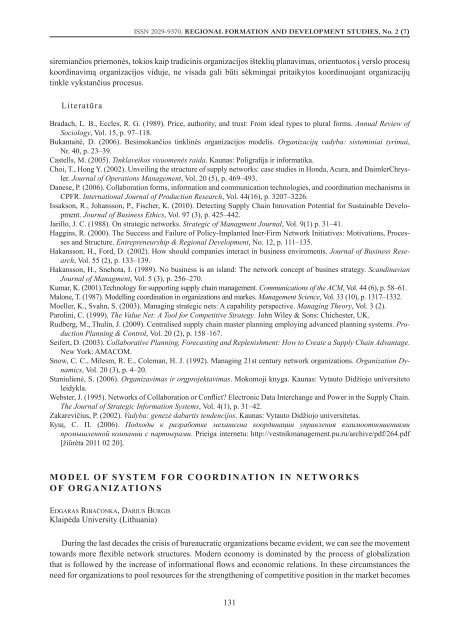regional formation and development studies - KlaipÄdos universitetas
regional formation and development studies - KlaipÄdos universitetas
regional formation and development studies - KlaipÄdos universitetas
You also want an ePaper? Increase the reach of your titles
YUMPU automatically turns print PDFs into web optimized ePapers that Google loves.
ISSN 2029-9370. Regional Formation <strong>and</strong> Development Studies, No. 2 (7)<br />
siremiančios priemonės, tokios kaip tradicinis organizacijos išteklių planavimas, orientuotos į verslo procesų<br />
koordinavimą organizacijos viduje, ne visada gali būti sėkmingai pritaikytos koordinuojant organizacijų<br />
tinkle vykstančius procesus.<br />
Literatūra<br />
Bradach, L. B., Eccles, R. G. (1989). Price, authority, <strong>and</strong> trust: From ideal types to plural forms. Annual Review of<br />
Sociology, Vol. 15, p. 97–118.<br />
Bukantaitė, D. (2006). Besimokančios tinklinės organizacijos modelis. Organizacijų vadyba: sisteminiai tyrimai,<br />
Nr. 40, p. 23–39.<br />
Castells, M. (2005). Tinklaveikos visuomenės raida. Kaunas: Poligrafija ir informatika.<br />
Choi, T., Hong Y. (2002). Unveiling the structure of supply networks: case <strong>studies</strong> in Honda, Acura, <strong>and</strong> DaimlerChrysler.<br />
Journal of Operations Management, Vol. 20 (5), p. 469–493.<br />
Danese, P. (2006). Collaboration forms, in<strong>formation</strong> <strong>and</strong> communication technologies, <strong>and</strong> coordination mechanisms in<br />
CPFR. International Journal of Production Research, Vol. 44(16), p. 3207–3226.<br />
Issakson, R., Johansson, P., Fischer, K. (2010). Detecting Supply Chain Innovation Potential for Sustainable Development.<br />
Journal of Business Ethics, Vol. 97 (3), p. 425–442.<br />
Jarillo, J. C. (1988). On strategic networks. Strategic of Managment Journal, Vol. 9(1) p. 31–41.<br />
Haggins, R. (2000). The Success <strong>and</strong> Failure of Policy-Implanted Iner-Firm Network Initiatives: Motivations, Processes<br />
<strong>and</strong> Structure. Entrepreneurship & Regional Development, No. 12, p. 111–135.<br />
Hakansson, H., Ford, D. (2002). How should companies interact in business enviroments. Journal of Business Research,<br />
Vol. 55 (2), p. 133–139.<br />
Hakansson, H., Snehota, I. (1989). No business is an isl<strong>and</strong>: The network concept of busines strategy. Sc<strong>and</strong>inavian<br />
Journal of Managment, Vol. 5 (3), p. 256–270.<br />
Kumar, K. (2001).Technology for supporting supply chain management. Communications of the ACM, Vol. 44 (6), p. 58–61.<br />
Malone, T. (1987). Modelling coordination in organizations <strong>and</strong> markes. Management Science, Vol. 33 (10), p. 1317–1332.<br />
Moeller, K., Svahn, S. (2003). Managing strategic nets: A capability perspective. Managing Theory, Vol. 3 (2).<br />
Parolini, C. (1999). The Value Net: A Tool for Competitive Strategy. John Wiley & Sons: Chichester, UK.<br />
Rudberg, M., Thulin, J. (2009). Centralised supply chain master planning employing advanced planning systems. Production<br />
Planning & Control, Vol. 20 (2), p. 158–167.<br />
Seifert, D. (2003). Collaborative Planning, Forecasting <strong>and</strong> Replenishment: How to Create a Supply Chain Advantage.<br />
New York: AMACOM.<br />
Snow, C. C., Milesm, R. E., Coleman, H. J. (1992). Managing 21st century network organizations. Organization Dynamics,<br />
Vol. 20 (3), p. 4–20.<br />
Staniulienė, S. (2006). Organizavimas ir orgprojektavimas. Mokomoji knyga. Kaunas: Vytauto Didžiojo universiteto<br />
leidykla.<br />
Webster, J. (1995). Networks of Collaboration or Conflict? Electronic Data Interchange <strong>and</strong> Power in the Supply Chain.<br />
The Journal of Strategic In<strong>formation</strong> Systems, Vol. 4(1), p. 31–42.<br />
Zakarevičius, P. (2002). Vadyba: genezė dabartis tendencijos. Kaunas: Vytauto Didžiojo <strong>universitetas</strong>.<br />
Кущ, С. П. (2006). Подходы к разработке механизма координации управления взаимоотношениями<br />
промышленной компании с партнерами. Prieiga internetu: http://vestnikmanagement.pu.ru/archive/pdf/264.pdf<br />
[žiūrėta 2011 02 20].<br />
MODEL OF SYSTEM FOR COORDINATION IN NETWORKS<br />
OF ORGANIZATIONS<br />
Edgaras Ribačonka, Darius Burgis<br />
Klaipėda University (Lithuania)<br />
During the last decades the crisis of bureaucratic organizations became evident, we can see the movement<br />
towards more flexible network structures. Modern economy is dominated by the process of globalization<br />
that is followed by the increase of in<strong>formation</strong>al flows <strong>and</strong> economic relations. In these circumstances the<br />
need for organizations to pool resources for the strengthening of competitive position in the market becomes<br />
131

















